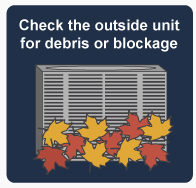
After a frigid winter and rainy spring, feeling the warm sun on your face is a welcome change of pace. While it might not be warm enough to turn on the A/C just yet, hot summer temperatures will arrive in a matter of weeks. By preparing your air conditioner in advance, you will keep your power bills lower and ensure the comfort of your home and your family’s health.
Major A/C Components 
Before preparing your air conditioner for the summer, it is a good idea to understand how it works. Central air conditioning units have three main components—the ductwork, condenser and blower unit.
The ductwork is the series of flexible metallic tubes that run throughout a home. Their job is to route conditioned air into your home and remove warm air. If your home seems dustier than usual or muggy during the summer, the ductwork may have a leak. Leaks cause conditioned air to blow into the spaces between the walls, making it more difficult and costly to cool your home. If you have never had the ducts inspected or cleaned, taking care of the task during the spring will help the A/C perform optimally and efficiently.
The condenser is the outdoor unit. It uses refrigerant to control the temperature in your home. When warm air flows over the evaporator coils, the refrigerant inside them absorb the heat. The change in pressure causes the refrigerant to change from a liquid into a gas. As the refrigerant cools, it condenses and resumes its liquid state.
When the refrigerant enters the blower unit, it changes into a cold gas and travels through a cooling coil. The blower unit draws warm air from your home through the return ducts. The A/C then pushes air over the cooling coils and back into your home. After the cycle, the refrigerant flows back into the condenser, where it converts into a liquid.
Steps for Preparing Your Air Conditioner
Filter Change
Filters protect the components within the air conditioner from dust, pollen and other particles that could damage the equipment. Dirty filters make it more difficult for the blower unit to circulate air, which could cause ice to form and the A/C to work harder than necessary.
Change the filter at least once a month.
If you notice ice forming on the A/C unit, call a licensed professional as soon as possible.
Keep the Outdoor Unit Debris-Free
Proper air circulation is essential to the health of your cooling equipment. Promote this by ensuring that nothing is around, on or near the outdoor unit. During the spring and summer:
- Turn off the thermostat and use a hose to gently wash away dirt from the outside of the unit and fins
- Remove debris, such as fallen leaves and twigs, that is on top or around the unit
- Keep the grass around the unit short
- Trim back bushes so they are a few feet away from the unit
- Trim back tree branches that overhang the unit
- Keep other items, such as wood piles and bicycles, a few feet away from the outdoor unit
Clean the Condensate Drain
The condensate drain is a thinner PVC pipe near the outdoor unit. When you run the A/C, you will see water dripping from the drain. Because of the moisture, it’s it normal for the drain to attract algae, which could clog the line. When algae and other debris clog the condensate drain, water may flow into your home. Alternatively, the float switch may trigger the cooling equipment to turn off.
To clean the condensate drain, remove the end of the drain, which often has 90-degree elbows. Then use a wet/dry shop vacuum to remove the water and sludge inside the line. When you finish, replace the end of the drain.
Check the Refrigerant Level
Locate the two copper lines that run to the condenser unit and identify the larger line, which might have insulation around it. The line should feel cold to the touch or sweat when the A/C runs. If the line feels warm after running the air conditioner, call an HVAC specialist to add coolant.
Level the Condenser Unit
Use a level to ensure the slab on which the condenser unit sits is level. If it is not, carefully elevate the end that slopes downward using a board and add small quantities of gravel until it is level. Remove the board when you finish.
One of the most steps when preparing the air conditioner for summer is scheduling an annual maintenance and inspection visit. Completing this task will help prevent costly breakdowns in the summer and keep the equipment’s warranty active. If you have any questions or concerns about operating or maintaining your air conditioner, do not hesitate to contact AAA Heating and Cooling for expert guidance.